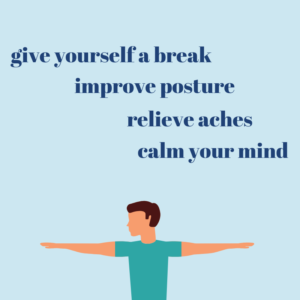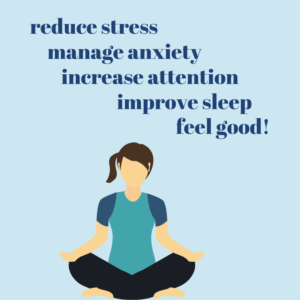Meditation and at-desk exercises are helpful methods for writers to stay productive, focused, and healthy. Anyone who has tried to write a book knows how much mental and physical strain it requires!
If you have recently written, you were probably interrupted at least once by racing thoughts of family, friends, or even the passing traffic outside your window. It can be hard to shut our brains down and focus on a singular task at hand in the midst of such busy lives. It can be even harder to stay focused when you’ve been sitting at a desk for so long. By exercising and meditating, authors can keep their brains and bodies strong and ready for focused work.
Keep reading to learn more about how meditation and at-desk exercises can help you!
- Meditation for authors
- Body scanning
- Breath awareness
- Loving-kindness
- Exercises for authors
- Neck stretches
- Arm stretches
- Hip stretches
Meditation for authors
Meditation is an ancient practice used to develop one’s attention and focus, while simultaneously achieving mental clarity. The power and benefits of meditation are numerous – this one act can physically train your brain to better handle stress, develop impulse control, and strengthen your body’s immunity.
Meditation is great for writers because so much of our work takes place in our heads. By learning how to meditate and practicing it, you can silence your brain for a little bit. Think of how your brain is active every moment of every day. A little break from all that business sounds nice, doesn’t it?
The best thing about meditation is that it can be done anywhere. You can do it at your desk, in the shower, while laying in bed, and so on.
While there are many meditation techniques, we want to focus on body scanning, breath awareness, and practicing loving-kindness.
Body scanning
Body scanning is a simple way to learn how your body is feeling in a moment of calm. To do it, go to a quiet room and close your eyes. You can stand or be seated. Slowly move throughout your entire body – beginning with your head and working your way to your toes – and see how you feel. This may be a good way to realize your wrists are sore from writing and that they need a little break.
Breath awareness
Breath awareness, much like body scanning, requires a quiet and peaceful space. Close your eyes and breathe in slowly, inhaling through the nose and exhaling through the mouth. If your mind begins to drift bring it back to your breath. Simply focus on what your breathing is like.
Loving-kindness
Finally, there is loving-kindness. Close your eyes, stand up with your back straight and relax your body. Think of the people you love most in the world. Imagine them sending you warmth and positivity, filling you with joy and a feeling of love.
For more information on types of meditation that are available to you, check out:
- Mindfulness in Plain English by Henepola Gunaratana,
- Wherever You Go, There You Are: Mindfulness Meditation in Everyday Life by Jon Kabat-Zinn, and
- 10% Happier: How I Tamed the Voice in My Head, Reduced Stress Without Losing My Edge, and Found Self-Help That Actually Works by Dan Harris.
Exercises for authors
If you’re looking for something to target more of the physically demanding side effects of writing, such as sore wrists, a tight neck, and hip pain from prolonged sitting, simple at-desk exercises may be what you need to alleviate these pains. By mastering and practicing just three moves, you can give your body a break from writing fatigue.

As the name denotes, at-desk exercises can be done… At. Your. Desk. How easy is that?! You can do them sitting down or standing up and (if you work in a busy office like me) they can be done pretty discreetly.
Neck stretches
To practice your at-desk neck exercise, sit up tall like someone is pulling you by puppet strings. Relax your shoulders and back completely, letting your shoulder blades slide down slightly. From there, tilt your head and neck to the neck and feel a stretch on your right side. Stay here for a bit. After you let gravity do its thing, you can gently stretch your neck further with your hand. Repeat on the other side.
Arm stretches
For your hands/arms, put your left arm out in front of you with one of your palms facing up at the ceiling. With your right hand, grab your left fingers and gently pull them down to stretch your forearm. Hold for thirty seconds, then repeat on the other side. This should feel great after all the writing and typing you’ve been doing!
Hip stretches
Lastly, a great stretch for your hips/legs is to sit in your chair and slide both of your hands underneath your right thigh. Pull your right knee up into your chest (stop if this feels painful). Hold for thirty seconds. Repeat on the left side.
I recommend watching YouTube videos of similar exercises and stretches to get a clear idea of what the movements look like. Some great options are:
- Desk Exercises To Do At The Office, by Forbes,
- Stretch Breaks at Your Desk, by Renown Health
- Yoga at Your Desk, by Yoga with Adriene.
If you’re a writer who has ever felt physically or mentally fatigued while writing, bringing meditation and gentle stretching exercises into your workspace could be what you need. Are there any techniques you’ve used in the past that have proven to be particularly effective? Let us know!


Kelsey,
Awesome post: well detailed enough. As a writer who intend to go full time with it, I found these really helpful and I’ll definitely give it a shot.
I type so much on my laptop that it really affects my fingers. If only I’ve found this post early enough.
Thanks, Cyrus! Hopefully a good wrist stretch can help you out.